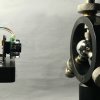.jpg)
Autonomic neuropathy is a common complication arising from diabetes, causing side effects like gastroparesis, erectile dysfunction, and other conditions due to damaged autonomic nerves. Early detection of diabetic autonomic neuropathy can have substantial benefits to patients thanks to treatment commencing sooner than it does now. Now researchers at National Taiwan University Hospital and National Chiao-Tung University in Taiwan developed an optical sensor that hangs off a pair of glasses and helps spot autonomic neuropathy by monitoring the activity of the eye for a half hour.
The device shines light from four color LEDs into the eye in order to stimulate the pupil to change size. It does this repeatedly, changing certain parameters, while a camera watches the pupil dilate in response to the light. By measuring the size of the pupil, its response time, and response speed, the researchers have shown that the new pupillometer may be a new modality for spotting autonomic neuropathy much earlier than what doctors are currently able to do. There are more extensive clinical trials planned to confirm the efficacy of the technology, with the hope that in a few years we’ll have convenient glasses that a patient can wear during a regular checkup to check for early signs of diabetes.
From the Optical Society:
Currently doctors rely on observing changes in digestive speed, heart rate and blood pressure to detect diabetic autonomic neuropathy, but this limits their ability to make a diagnosis early on, said Mang Ou-Yang, who led the research with colleagues at National Chiao-Tung University. Now they have shown that monitoring the pupils of people with diabetes may be a better approach.
“Compared to the existing diagnostic techniques, the pupillometer is a more reliable, effective, portable and inexpensive solution for diagnosing diabetic autonomic neuropathy in its early stages,” said Ou-Yang.
The pupil is useful for detecting diabetic autonomic neuropathy due to the neurological conditions caused by the disease. Like many organs, the eyes and pupil are dually innervated, receiving signals from both the parasympathetic and sympathetic divisions of the autonomic nervous system. These divisions control the pupil’s circular and radial muscles, respectively.
Source:National Taiwan University Hospital
New Eye Monitoring Device Spots Early Signs Of Diabetes

